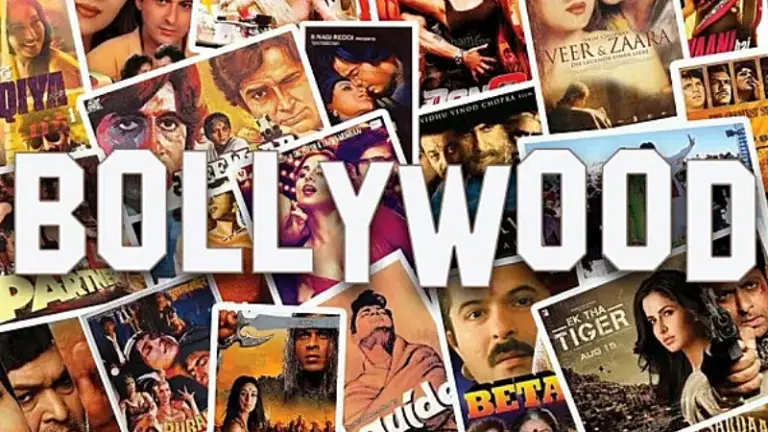Bollywood is a portmanteau of Bombay and Hollywood

Bollywood is the informal term used for the Hindi-language film industry based in Mumbai (formerly known as Bombay), India. It is the largest film industry in the world in terms of production and viewership. The term “Bollywood” is a portmanteau of Bombay and Hollywood. Bollywood films typically feature song-and-dance routines, romantic plotlines, and elaborate production […]
Bollywood is the informal term used for the Hindi-language film industry based in Mumbai (formerly known as Bombay), India. It is the largest film industry in the world in terms of production and viewership. The term “Bollywood” is a portmanteau of Bombay and Hollywood.
Bollywood films typically feature song-and-dance routines, romantic plotlines, and elaborate production numbers. They are known for their vibrant colors, music, and larger-than-life characters. The films often explore family values, love, social justice, and patriotism.
Bollywood has a massive global audience, with fans across Asia, the Middle East, Europe, Africa, and North America. Some of the biggest Bollywood stars include Shah Rukh Khan, Amitabh Bachchan, Aishwarya Rai Bachchan, Priyanka Chopra, and Deepika Padukone.
The origins of Bollywood can be traced back to the early 1900s when the first silent Indian films were produced in Mumbai. These early films were heavily influenced by British and American cinema and had a Westernized style.
In the 1930s and 1940s, Indian filmmakers started experimenting with adding music and dance to their films, which became increasingly popular among audiences. The first Bollywood musical, “Alam Ara” was released in 1931 and was a huge success.

The first Bollywood musical, “Alam Ara” was released in 1931 and was a huge success.
In the post-independence era, Bollywood emerged as a distinct and significant film industry, producing films in Hindi for a pan-Indian audience. The 1950s and 1960s were considered the golden age of Bollywood, with the emergence of legendary actors like Raj Kapoor and Dilip Kumar, and the creation of timeless classics like “Mughal-e-Azam” and “Mother India.”
Over the years, Bollywood has evolved and adapted to changing cultural and social trends. Today, it is a global phenomenon with a massive following worldwide.
Bollywood is not just a film industry; it is an emotion, a passion, and a way of life for millions of people. It is a cultural phenomenon that has captured the hearts of people across the globe with its vibrant colors, melodious music, and larger-than-life characters.
Bollywood films are not just movies; they are a complete package of entertainment, drama, romance, and action. They are known for their catchy songs and dance sequences that make people want to get up and groove. From traditional folk music to modern-day techno beats, Bollywood has something for everyone.
One of the things that sets Bollywood apart from other film industries is its star system. Bollywood has produced some of the biggest and most iconic stars in the world, who have become household names not just in India but across the globe. Actors like Amitabh Bachchan, Shah Rukh Khan, Aishwarya Rai Bachchan, and Priyanka Chopra have a massive fan following worldwide and are considered cultural icons.
Apart from the stars, Bollywood has also produced some of the most memorable films ever. Films like “Sholay,” “Mughal-e-Azam,” “Dilwale Dulhania Le Jayenge,” and “Lagaan” have not just been box office hits but have also become a part of popular culture.
Bollywood has also played a significant role in shaping India’s cultural identity. The films have explored themes like love, family values, social justice, and patriotism, which resonate with people across the country. They have helped to create a sense of unity and togetherness among people from different backgrounds.
However, Bollywood is not without its controversies. The industry has faced criticism for its portrayal of women, its lack of diversity, and its nepotistic practices. In recent years, the industry has also come under scrutiny for its alleged involvement in drug use and other illegal activities.
Despite these challenges, Bollywood continues to thrive and evolve. With the rise of streaming services and social media, Bollywood is now more accessible than ever, with a growing global audience. The industry is also slowly changing, with more diverse and inclusive films being produced and new talent being given a chance to shine.
In conclusion, Bollywood is more than just a film industry; it is a cultural phenomenon that has captured the hearts and minds of people across the globe. It has produced some of the most iconic stars and films of all time and has played a significant role in shaping India’s cultural identity. Despite its challenges, Bollywood continues to evolve and adapt to changing times, and its future looks bright.





प्रातिक्रिया दे